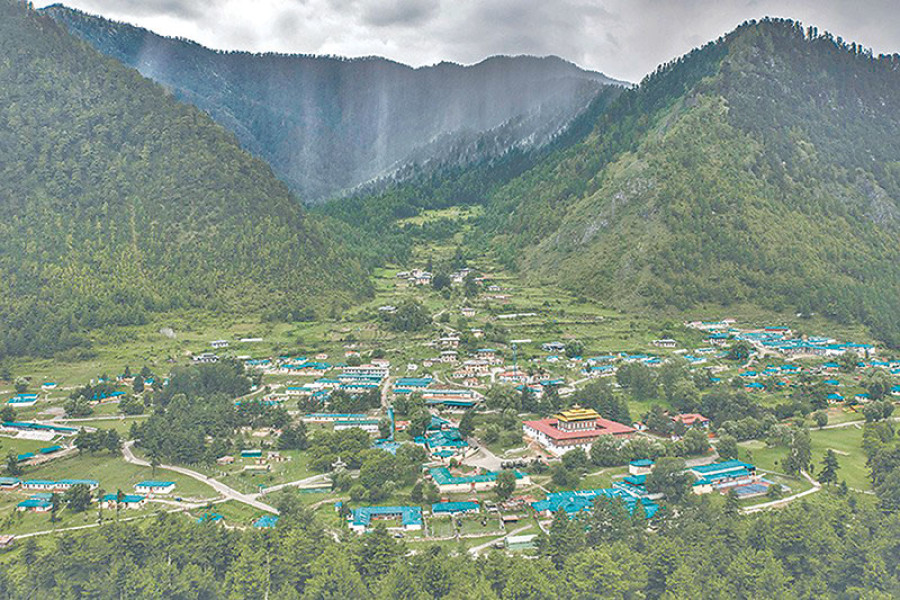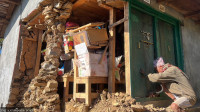Opinion
Of mountains and imaginations
Nepal and Bhutan could build mountain ports to make it a global hub for highlands around the world
Mahendra P Lama
Globalisation and market driven economic systems are all about purchasing power and ability to trigger effective demand. There is no ‘life’ in Kathmandu, Delhi, Beijing, Hanoi or Tokyo if one’s pocket is empty. Forty years back all the pass time games in mountain areas during students’ winter vacation used to be something to do with nature where no one really needed to put cash. From a simple blind folded game like ‘Am I right?’ to putting marble on a small targeted hole to setting up small green bush covered camouflaged camps in the hillocks to sit, gossip and cook the freely available roots and vegetables were something everyone enjoyed thoroughly. The core of these games of course was understanding and harnessing nature, mental alertness, physical engagement and more so social camaraderie. None of these games could be bought and sold yet they gave immense long lasting satisfaction.
A new direction
Back home in Darjeeling town Saraswati puja, Buddha Purnima, Bhanu jayanti and Vishwakarma puja besides Dashain, Tihar, Maghe and Sawane Sankratis and Christmas provided the best opportunities for all to gather, enjoy and reconnect. The concept of ‘samaj’, a local community institution, was very critical in their socio-cultural and political mobilisation. Every village had a ‘samaj’ that embraced all castes, race, religion and language. Each samaj had stock of utensils, musical instruments,instruments, disaster management knowledge, social service responsibilities, water distribution channels and more critically practice of traditional medicinal systems. Everything seemed to be happening so smoothly as the systems were well set and abided by all. There was very little government around. Everybody had a sense of imagination and enjoyed dreaming. Both these subjective items actually do not cost anything accept mental and spiritual engagement.
It was this imagination and dream that partly brought the British colonial vestiges to Darjeeling and started the famous Darjeeling tea, world celebrated cinchona plantation for anti-malarial drugs and a Himalayan railway, mostly between 1850s to 1880s. This is for the first time Campbell, Hooker, Aitchison, Lloyd, Grant, Eden all came together to start ‘mountain ports’ far away from riverine and sea ports like in Calcutta and Chittagong. The ‘Lahures’— - Gorkha army recruits in India and other parts of the world also just imagined and dreamt of crisscrossing the marine frontiers and mountain topography. Their story of valour and single-mindedness stretching now even to providing security at the Trump-Kim summit in Singapore have something to do with their mountain habits of incessant imagination and versatile dreams. These syndromes are well covered in mountain literature. Acclaimed Nepali poet Laxmi Prasad Devkota once wrote “imagination is actually the heart of happiness”.
Two astoundingly beautiful and largely virgin mountain geographies, Bhutan and Nepal stand to gain most from the concept of mountain ports. Both these countries are bio-diversity hotspots, the vanguard of ‘free’ natural oxygen and also considered as civilisational gorge in the Eastern Himalayas. Bhutan’s young Monarch and Nepal’s present pPrime mMinister have shown tremendous depth of imagination and width of dreaming in their public discourses. It is this creative instinct that set them apart from humbug socio-political rigmarole. Both of them tend to abidingly promote the core of mountain cultural ecology and geo-morphology as a strategic element in their nation building project. If Bhutan mesmerises the global community with the gross national happiness bid and Nepal protractedly harps on tTrans-Himalayan multi-dimensional connectivity network with its southern and northern neighbours, both these leaders could provide a new discourse and orientation to the idea of mountain ports. Though in the lexicon of ports—both dry and marine—- primarily stress on connectivity, exchange of goods and services, movement of people and technology, the mountain ports could trigger a new direction to the idea of port by primarily focussing on nature, knowledge, community and technology.
Global world is insatiably hungry today for something natural, much deeper than the factories and far away from the urban conglomerates. Americans in New York and Germans in Hamburg imagine and dream of moving away from the pestering atmosphere of urban conglomerates to Machu Picchu in Peru and Karakoram in Pakistan. The Japanese do exactly that when they dive into the ‘onsen’ hot springs of Hakone in Kanagawa. When Mamta Banerji came across Lamahatta in Darjeeling, her imagination knew no bounds. For at least a few moments she was enlightened;, just floated and entrenched into wild imagination and thoughtful dreams.
All mountain ports could be focussed on local or national history, unparallel advantages and uniqueness. Nepal and Bhutan could lay out a range of mountain ports across the country. It is worth investing in these ports as has been proved by prolific sea ports across the world. These mountain ports could trigger huge global attention and investors and philanthropists could throng these ports. These ports could also induct transforming connectivity to the crucial geographies. Can Bhutan and Nepal have cCentres of eExcellence on cClimate change in their alpine topography? No country could have the wherewithal and natural advantage than these two countries to undertake this. Agricultural heritage to glaciology melt, wild life protection to animal husbandry, new genres of diseases and disasters to migration of transhumance and livelihood to genetic degeneration could encompass the ingredients of these Centres. For instance, can these two countries not put together a mountain veterinary school amidst the far reaching impact on livestock and vanishing wildlife in the mountains?
Globalisation of Locals
When the then Prime Minister of Nepal convened the meeting of his cabinet on global warming and climate change at Kalapatthar in the base camp of Mount Everest in 2009, it was a refreshing news. For the first time Nepal tried to demonstrate and assert its core competence. The Chinese, the Dutch, Kyrgyz and the Australians are looking for such expertise and facilities. This would actually be the starting point of the much ignored globalisation of local knowledge, community adaptation and monetisation of invaluable mountain wisdom. This will reverse the existing overwhelming trend of localisation of globals like Hyundai, Airtel, Pepsi, Pizzas and Louis Vuitton. This could start the process of globalisation of locals and generate a huge entrepreneurship and commercial ventures. Then only a Nepali farmer’s knowledge in preventing and curing Chirke-Phurke virus in cardamom plant will reach the communities in Latin America and Africa. Nepal’s much politicised trade deficit could then be no talking point.
Can Nepal develop a history museum waxing eloquent the valour of the Gorkhas and wars as a mountain port? Can Bhutan make a mountain port on just the history of Monarchy at Punakha? The Chinese experience in building a private museum, now made famous by Jianchuan Museum in Chengdu, Sichuan which showcases private collection of artefacts is just the beginning of the story. There is ample scope to develop these mountain ports. It could include archaeology, architecture, hydrodel power, trade and pilgrimage routes, textiles-fashion- ornament- musical instruments, information technology, mountain sports, bio-technology, traditional medicinal practices, bio-diversity and ethnicity. Any of these well designed activities will lead to a specialised mountain port in seven provinces of Nepal and twenty ddzongkhags of Bhutan. This will build skills and capacity among the younger generation, proliferate the related institutions, facilitate access to global market, refurbish indigenous research and development and more critically, harness its own unexplored potentials.
Students, teachers, civil society members and professionals from across the world will come for various courses and programmes and trainings to Nepal and Bhutan. This will reverse the brain drain process too. All these will bring global leadership to these mountainous countries. Unlike in the past, the so-called Least Developed countries will lead the global discourse on mountain regions. This is where Bhutanese Monarch and Nepalese Prime Minister could start the process of transforming their countries into global players. Here also too, imagination and the dreaming is the key.
Lama drafted the First Plan of Darjeeling Gorkha Hill Council in 1989 and also plan documents of Government of Sikkim during 2000-2007




 7.12°C Kathmandu
7.12°C Kathmandu










